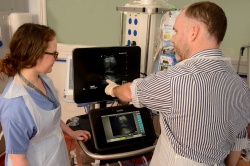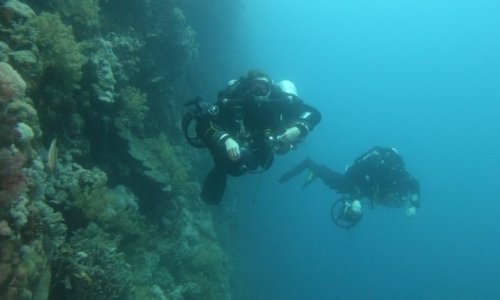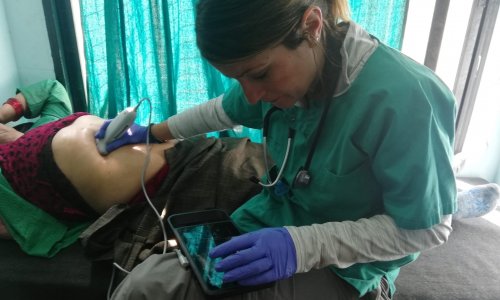POC
SonoSite’s X-Porte® helps to provide continuity of care
Point-of-care ultrasound systems play an important role in the treatment of complicated medical cases at the Royal Surrey County Hospital in Guildford, as consultant intensivist and anaesthetist Dr Justin Kirk-Bayley explained.


The Royal Surrey County Hospital is a 527-bed general hospital and a specialist tertiary centre for cancer, oral and maxillofacial surgery and pathology. As a major cancer centre, the hospital treats some very difficult and complicated patients, and so has a larger than average 28-bed intensive care unit (ICU). The hospital is also a national leader for enhanced recovery after surgery, enabling more cancer surgery to be performed as patients spend less time in the ICU. Point-of-care ultrasound plays an important role across departments and in a range of procedures, and the hospital has invested in a number of SonoSite instruments – including M-Turbo®, Edge®, S-Nerve™ and "X-Porte"® systems – across various departments.
In recent years, I have taught ultrasound techniques extensively, and our department is starting to push some frontiers in terms of the development of ultrasound skills, keeping pace with other key opinion leaders. It has become clear that a good knowledge of the use of ultrasound is essential for both anaesthesia and intensive care. In the intensive care environment, ultrasound guidance is always used for line placement and the insertion of chest drains, and echocardiography is increasingly common, particularly since the establishment of FICE (focused intensive care echocardiography) a couple of years ago. Lung ultrasonography is another application with great potential; although still a fledgling technique in the UK, it is already established in some areas of Europe, particularly in France. To help us perform these more advanced examinations, we have invested in a SonoSite "X-Porte" point-of-care ultrasound system.
One of the major difficulties in treating intensive care patients is that they cannot usually be transferred to radiology for an ultrasound scan. Training ICU staff to perform some of the more routine scans can help to overcome this issue. We already had a SonoSite Edge in the ICU, and the radiology department had an "X-Porte" system. Investing in an "X-Porte" for the ICU, complementing our existing system and that in radiology, not only offered us advanced ultrasound capabilities, it also ensured continuity for attending radiologists, providing access to familiar equipment of the high quality that they are used to, and enabling them to make a good assessment of the patient’s condition. For similar reasons, when the A&E department was looking for a point-of-care ultrasound system we suggested the "X-Porte", giving the critical care outreach service the same continuity when they are called to attend patient resuscitation and other difficult cases.
Whenever we purchase new equipment, it is important that it is as future-proof as possible. With the "X-Porte", not only is the hardware fantastic, but the platform is heavily software-based, and therefore dynamic. This will allow it to evolve with us, as subsequent enhancements are not limited by hardware constraints. It is also essential that any downtime is as short as possible, and the design of the "X-Porte" allows the central processing unit to be quickly and easily exchanged should it prove necessary, without the need to remove the instrument for off-site repair.
We’ve had our "X-Porte" for a few months now, and it has proved very popular, enthusing my colleagues and becoming the ‘go-to’ instrument. It is very reliable, and offers an image quality previously seen only in the hands of an echocardiographer or a radiologist, with a nice wide viewing angle, allowing us to perform the more advanced echocardiography needed for FICE. It is simply a generation ahead. The touch screen user interface, although quite different, is very intuitive; with smartphones and tablet computers commonplace, most people using the "X-Porte" are already familiar with – and have expectations of – this type of interface. The system is very mobile, the height can be quickly and easily adjusted, and the large screen is fantastic. This allows me to position the "X-Porte" so that I have a good view of the screen while scanning, and everybody else within that bed space can see the image too, which is ideal for training purposes and makes it easier to explain the procedure to the patient. The learning modules on the "X-Porte" are interesting too and, in time, I’d like to integrate them into my teaching.
We have a fantastic relationship with SonoSite, and that was factored into the tendering process, taking into consideration not only the capabilities and reliability of the instrument, but also the quality of service, the warranty, and the level of customer support. We looked at other systems but, when compared objectively, the "X-Porte" was leagues ahead. When you put the whole package together, it just leaves everything else standing.
Source: SonoSite
01.04.2016











